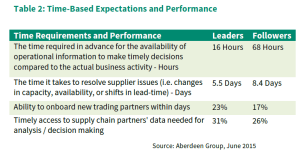5 Ways to Improve Your Supplier Onboarding
Last Published: Dec 23, 2021 |

Today, your suppliers are seen as a source of know-how and innovation leading towards a new way of collaborating and interacting with. Effectively managing suppliers, supplier relationships and their information is of growing strategic importance and value. If your organization has a strong supplier relationship management (SRM), collaboration and engagement, you will benefit of a true competitive advantage.
The foundation of a powerful SRM and successful supplier communication is an effective and diligent supplier onboarding process. However, vendor onboarding is often managed by various regional teams and supplier information is stored in multiple, siloed systems. This is especially true in large, global organizations. As a result, onboarding is not a consistent, standardized and centrally managed process and can take several months.
According to the Aberdeen report, The Value of Strategic Supplier Data Management, Supply Chain Leaders are over 30% more likely to have an efficient supplier data management process to accelerate supplier onboarding. This report, which is based on a recent survey of supply chain and sourcing practitioners, describes what separates the Leaders from the Followers among procurement organizations.
The qualification and onboarding of new suppliers is often owned by strategic sourcing, procurement or supply chain management teams. If they take a strategic approach to the qualification and onboarding of their vendors, they will save time, reduce risk and improve communication and compliance. Moreover, streamlining supplier onboarding can have a positive impact on purchasing costs, company data quality and corporate image, and even drive top line growth.
Here are 5 best practices that help streamline the supplier onboarding process:
- Global Consistency and a Supplier 360 View Ensure that your supplier onboarding process is consistent across all global locations and that standards are in place for all suppliers regardless of size. Many companies use different, siloed systems with fragmented and inconsistent supplier data. Use technology that is able to manage, master and connect your supplier data and that provides you with a 360-degree view of your suppliers, existing supplier relationships across the organization and the products or services they supply. This can also help you benefit from or negotiate better corporate pricing and payment terms.
- Supplier Self-Service Portal It can take several weeks to receive all relevant supplier information required for the onboarding process and to have it reviewed and approved by all stakeholders, such as sourcing, supply chain or financial teams. Automating supplier onboarding processes using a supplier self-service portal combined with a supplier relationship management application speeds-up this process for both parties - the supplier and the buyer. Look for solutions that allow the supplier to upload its product catalogues within the same portal. This reduces manual work-load and onboarding time and speeds-up time to market for a new product introduction or the start of a new project.
- Access to Relevant, Complete and Validated Data Incomplete or incorrect contact information or product data can harm your business. During the onboarding process, make sure you receive relevant, complete and validated information from your suppliers. This will help you quickly get answers to specific questions or to resolve issues. Standardizing your data and implementing data quality rules and validation services (e.g., global address, e-mail and phone-number) will improve your supplier relationship and communication from the start. If you leverage a supplier self-service portal, your suppliers can also update their company, contact and product information at any time. This saves time and helps ensure that the supplier data is up-to-date.
- Reduce Risk and Fraud from the Beginning Carefully assessing and prequalifying a new supplier is crucial to avoid supplier risk and to reduce fraud. Reduce supplier risk and ensure supplier compliance during the onboarding process by using checklists and standardized workflows. Make sure you communicate your organization’s values and that the supplier aligns with them. Use supplier risk questionnaires embedded in the online approval process. Questions should be configurable based on your company’s requirements, industry standards and the products or services provided. They may contain the categories, insurance, safety, environment, sustainability, legal and financial information or sub-suppliers.
- Make other Systems and Business Processes Benefit Once you have successfully on-boarded a new supplier, leverage your clean, consistent and connected supplier information to fuel other business-critical applications, such as ERP or Product Information Management (PIM) systems.
Download the full Aberdeen Report "The Value of Strategic Supplier Data Management" .








